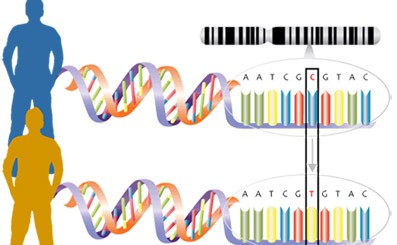How Gene Mutations Change Your Ability to Taste
Summary
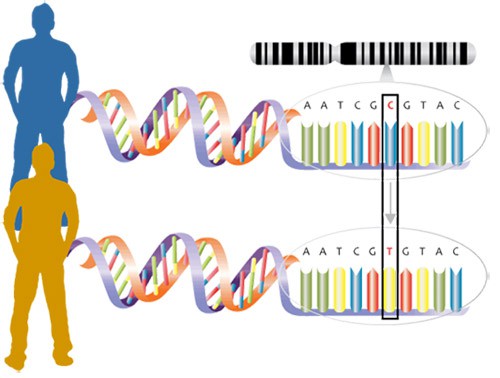 Image Credit: Creative Commons Attribution 2.0 Generic license
Image Credit: Creative Commons Attribution 2.0 Generic license
Overview
Explore genetic variation through the world of taste in this problem-solving lesson plan. Working both individually and collaboratively, students figure out what kind of tasters they are, what this means about their own genetics, and how genetic mutations can lead to functional differences. This activity provides a hands-on, personalized opportunity to learn about how genotypes and phenotypes align.Learning Objectives
- Understand the relationship between genotype and phenotype
- Describe how single nucleotide mutations sometimes lead to protein changes
- Explain how traits are inherited
- Understand causes of genetic variation
NGSS Alignment
This lesson helps students prepare for these Next Generation Science Standards Performance Expectations:- MS-LS3-1. Develop and use a model to describe why structural changes to genes (mutations) located on chromosomes may affect proteins and may result in harmful, beneficial, or neutral effects to the structure and function of the organism.
- MS-LS3-2. Develop and use a model to describe why asexual reproduction results in offspring with identical genetic information and sexual reproduction results in offspring with genetic variation.
|
Science & Engineering Practices
Asking Questions and Defining Problems.
Ask questions that arise from careful observation of phenomena, models, or unexpected results, to clarify and/or seek additional information.
Analyzing and Interpreting Data. Analyze and interpret data to provide evidence for phenomena. Constructing Explanations and Designing Solutions. Apply scientific reasoning to show why the data or evidence is adequate for the explanation or conclusion. Engaging in Argument from Evidence. Construct, use, and/or present an oral and written argument supported by empirical evidence and scientific reasoning to support or refute an explanation or a model for a phenomenon or a solution to a problem. |
Disciplinary Core Ideas
LS3.A: Inheritance of Traits
Genes are located in the chromosomes of cells, with each chromosome pair containing two variants of each of many distinct genes. Each distinct gene chiefly controls the production of specific proteins, which in turn affects the traits of the individual. Changes (mutations) to genes can result in changes to proteins, which can affect the structures and functions of the organism and thereby change traits.
Variations of inherited traits between parent and offspring arise from genetic differences that result from the subset of chromosomes (and therefore genes) inherited. LS3.B: Variation of Traits In addition to variations that arise from sexual reproduction, genetic information can be altered because of mutations. Though rare, mutations may result in changes to the structure and function of proteins. Some changes are beneficial, others harmful, and some neutral to the organism. |
Crosscutting Concepts
Structure and Function.
Complex and microscopic structures and systems can be visualized, modeled, and used to describe how their function depends on the shapes, composition, and relationships among its parts, therefore complex natural structures/systems can be analyzed to determine how they function.
Cause and Effect: Mechanism and Prediction. Cause and effect relationships may be used to predict phenomena in natural or designed systems. |
Materials
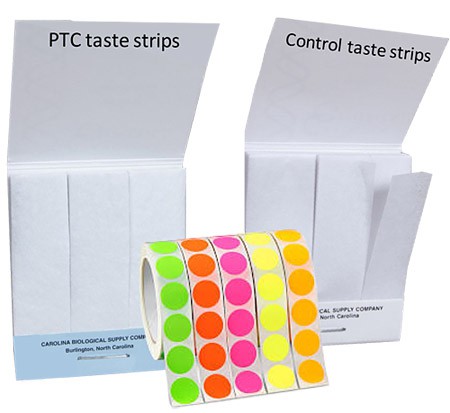
Materials for each student:
- Paper test strip, control (1); available from Carolina Biologial.
- Paper test strip, PTC (1); available from Carolina Biological.
- Handouts with "taster" or "non-taster" gene sequence (2 sequences per student). Each student gets two sequences dependent on his/her observed phenotype ("taster," "non-taster," or "in-between").
- Stickers or colored armbands, etc., that you can use to color-code students according to their phenotype.
Background Information for Teachers
This section contains a quick review for teachers of the science and concepts covered in this lesson.The genetic material within our cells, our genome, plays a large role in determining our traits, such as how we look and how we function. Every person—with the exception of identical twins, triplets, etc.—has a unique set of genes inherited from their parents. These genes consist of DNA (deoxyribonucleid acid). DNA is a genetic code that is made up of four different nucleotides that each include a different base molecule: adenine (A), thymine (T), guanine (G), and cytosine (C). The nucleotides are organized in a double helix structure, made up of two complimentary DNA strands: the sense, or coding, strand, and the antisense strand. The antisense DNA strand is turned into RNA (ribonucleic acid) in our bodies in a process called transcription.
The resulting RNA has the same sequence as the sense strand of the DNA; the only difference is that in RNA, a nucleotide called uracil (U) substitutes for each thymine molecule. The RNA then goes through a process called translation to turn into amino acids (Figure 1). During translation, every three RNA nucleotides encodes a single amino acid. This set of three nucleotides is called a codon, and different codons may code for the same amino acid, as shown in Figure 2. In the end, a sequence of DNA is turned into a sequence of amino acids joined together in a long chain, which is called a protein. Proteins are responsible for most our cell function.
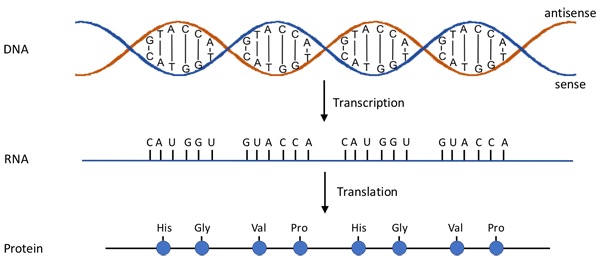 Image Credit: Svenja Lohner, Science Buddies / Science Buddies
Image Credit: Svenja Lohner, Science Buddies / Science Buddies
Figure 1. A DNA sequence is first transcribed into RNA, and then translated into a protein.
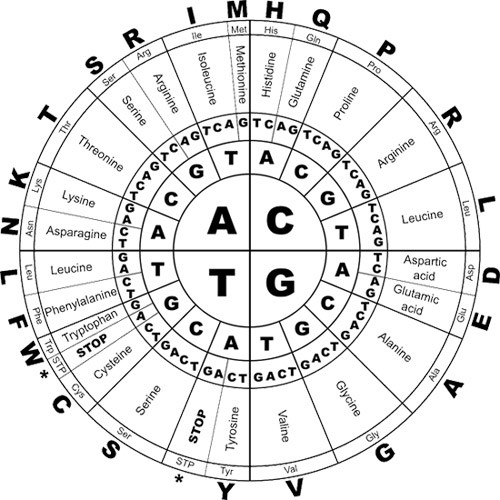 Image Credit: Pixabay / Public Domain
Image Credit: Pixabay / Public Domain
Figure 2. In the genetic code, every nucleotide triplet (codon) encodes for one amino acid. Some codons are "stop" codons, which signal the end of a protein.
Many things can happen during this process that can result in an altered structure of the protein or prevent a gene from turning into a functional protein. For example, if a single DNA nucleotide is mutated in a gene from an adenine (A) to a guanine (G), this may cause the wrong amino acid to be made. This is called a missense mutation. If the wrong amino acid is made and assembled into a long chain of amino acids, the resulting protein might have different properties than intended, or might not work at all. This is because different amino acids have different characteristics, which affects how they interact with each other as well as the molecules that surround them. Other single DNA nucleotide mutations might not lead to a change in the amino acid sequence, in which case they are called silent mutations and do not have any effects on the protein function.
Gene mutations may result in the same gene occurring in slightly different versions. These variants are called alleles. For example, a gene that encodes for a flower's color can have a purple-flower allele or a white-flower allele. The set of alleles that a person inherits make up the individual's genotype. As each person inherits two alleles—one from each parent —these two alleles can be the same, in which case the person is called a homozygote, or different, which is called a heterozygote. The traits, or observable characteristics such as color, shape, behavior, or other properties of an organism that result from the expression of its genotype, is called the phenotype. In the flower color example, this would mean that depending on what alleles are present in the plant, its phenotype (flower color) would be purple or white. This is simple if a plant has two purple alleles or two white alleles, but what if it has one white and one purple allele? In this case, it depends on which allele is dominant and which is recessive. The dominant allele always determines the phenotype, which explains why different genotypes can produce the same phenotype.
Over time, numerous mutations have created a great variety of alleles in the human genome, which is the reason for the genetic variety we see. In this lesson plan, students will explore how mutations in a taste receptor gene have resulted in two phenotypes, a "taster" and a "non-taster," with respect to a certain chemical called phenylthiocarbamide, or PTC. Depending on alleles present in their genome, students will either be able to taste bitterness in the PTC sample, or will not detect a taste in the PTC at all. Researchers have found that this difference is based on three single nucleotide mutations in the PTC receptor gene. Students will find out if they are a PTC "taster" or "non-taster" and will explore the reason for the two different phenotypes.


